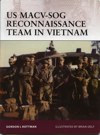 U.S. MACV-SOG Reconnaissance Team in Vietnam, by Gordon L. Rottman, Osprey Publishing, 2011
U.S. MACV-SOG Reconnaissance Team in Vietnam, by Gordon L. Rottman, Osprey Publishing, 2011
Established on January 24, 1964, the special unit going by the innocuous-seeming moniker of Military Assistance Command, Vietnam, Studies and Observation Group—but better known by its more menacing shadowy initials, MACV-SOG—was indeed meant for “studies and observation,” but it did its studying and observing within the network of Communist logistical roads running through Laos and Cambodia known as the Ho Chi Minh Trail. To gather such vital intelligence in such a dangerous environment, punctuated on occasion by sabotage and killing selected enemy personnel, required the skills of Special Forces, SEALs and other individuals whose training and tactical flexibility went beyond the norm.
The basic element—and for its members, their in-country universe—was the RT, or reconnaissance team, consisting of three Americans and three to nine indigenous guerrilla fighters (Vietnamese, Cambodian, Laotian or Montagnard) for whom no mission was routine and no hard and fast tactical rule applied. They carried out their missions in absolute mutual cooperation, because more than their lives depended on it—49 American and scores of indigenous SOG personnel remain MIA, and given their policy of not being taken prisoner, they are probably lost to the jungle forever. Virtually all of them were wounded at some time in their operations, which with the missing and 407 known dead gives the RTs a total casualty rate of 100 percent. But they provided MACV with 75 percent of its most accurate intelligence on the Ho Chi Minh Trail and they were directly or indirectly responsible for as many as 158 enemy killed for every one of their own dead.
The clandestine nature of its operations gave MACV-SOG a mythical aura during and since the Vietnam War, but with its declassification in the 1980s the reality behind the legends can now be told. Author Gordon L. Rottman tells it with the authority of a Viet vet, backed by a wealth of declassified photos—many taken on missions. Providing even more colorful details are the illustrations by Brian Delf of the weapons and equipment used by these covert warriors, along with graphic representations of typical actions of a MACV-SOG reconnaissance team in the jungles of Vietnam—a staple of Osprey’s “Warrior” series.
—Jon Guttman




